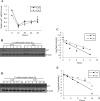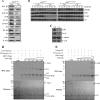Mammalian alteration/deficiency in activation 3 (Ada3) is essential for embryonic development and cell cycle progression
- PMID: 22736770
- PMCID: PMC3436190
- DOI: 10.1074/jbc.M112.378901
Mammalian alteration/deficiency in activation 3 (Ada3) is essential for embryonic development and cell cycle progression
Abstract
Ada3 protein is an essential component of histone acetyl transferase containing coactivator complexes conserved from yeast to human. We show here that germline deletion of Ada3 in mouse is embryonic lethal, and adenovirus-Cre mediated conditional deletion of Ada3 in Ada3(FL/FL) mouse embryonic fibroblasts leads to a severe proliferation defect which was rescued by ectopic expression of human Ada3. A delay in G(1) to S phase of cell cycle was also seen that was due to accumulation of Cdk inhibitor p27 which was an indirect effect of c-myc gene transcription control by Ada3. We further showed that this defect could be partially reverted by knocking down p27. Additionally, drastic changes in global histone acetylation and changes in global gene expression were observed in microarray analyses upon loss of Ada3. Lastly, formation of abnormal nuclei, mitotic defects and delay in G(2)/M to G(1) transition was seen in Ada3 deleted cells. Taken together, we provide evidence for a critical role of Ada3 in embryogenesis and cell cycle progression as an essential component of HAT complex.
Figures









Similar articles
-
Alteration/deficiency in activation-3 (Ada3) plays a critical role in maintaining genomic stability.Cell Cycle. 2012 Nov 15;11(22):4266-74. doi: 10.4161/cc.22613. Epub 2012 Oct 24. Cell Cycle. 2012. PMID: 23095635 Free PMC article.
-
Acetylation of Mammalian ADA3 Is Required for Its Functional Roles in Histone Acetylation and Cell Proliferation.Mol Cell Biol. 2016 Sep 12;36(19):2487-502. doi: 10.1128/MCB.00342-16. Print 2016 Oct 1. Mol Cell Biol. 2016. PMID: 27402865 Free PMC article.
-
Alteration/Deficiency in Activation 3 (ADA3) Protein, a Cell Cycle Regulator, Associates with the Centromere through CENP-B and Regulates Chromosome Segregation.J Biol Chem. 2015 Nov 20;290(47):28299-28310. doi: 10.1074/jbc.M115.685511. Epub 2015 Oct 1. J Biol Chem. 2015. PMID: 26429915 Free PMC article.
-
[Molecular mechanisms controlling the cell cycle: fundamental aspects and implications for oncology].Cancer Radiother. 2001 Apr;5(2):109-29. doi: 10.1016/s1278-3218(01)00087-7. Cancer Radiother. 2001. PMID: 11355576 Review. French.
-
Histone acetylation and the cell-cycle in cancer.Front Biosci. 2001 Apr 1;6:D610-29. doi: 10.2741/1wang1. Front Biosci. 2001. PMID: 11282573 Review.
Cited by
-
Alteration/deficiency in activation-3 (Ada3) plays a critical role in maintaining genomic stability.Cell Cycle. 2012 Nov 15;11(22):4266-74. doi: 10.4161/cc.22613. Epub 2012 Oct 24. Cell Cycle. 2012. PMID: 23095635 Free PMC article.
-
Genes conserved in bilaterians but jointly lost with Myc during nematode evolution are enriched in cell proliferation and cell migration functions.Dev Genes Evol. 2015 Sep;225(5):259-73. doi: 10.1007/s00427-015-0508-1. Epub 2015 Jul 15. Dev Genes Evol. 2015. PMID: 26173873 Free PMC article.
-
Evidence for differential alternative splicing in blood of young boys with autism spectrum disorders.Mol Autism. 2013 Sep 4;4(1):30. doi: 10.1186/2040-2392-4-30. Mol Autism. 2013. PMID: 24007566 Free PMC article.
-
Loss of the Nuclear Pool of Ubiquitin Ligase CHIP/STUB1 in Breast Cancer Unleashes the MZF1-Cathepsin Pro-oncogenic Program.Cancer Res. 2018 May 15;78(10):2524-2535. doi: 10.1158/0008-5472.CAN-16-2140. Epub 2018 Mar 6. Cancer Res. 2018. PMID: 29510992 Free PMC article.
-
ADA3 regulates normal and tumor mammary epithelial cell proliferation through c-MYC.Breast Cancer Res. 2016 Nov 16;18(1):113. doi: 10.1186/s13058-016-0770-9. Breast Cancer Res. 2016. PMID: 27852327 Free PMC article.
References
-
- Schafer K. A. (1998) The cell cycle: a review. Vet. Pathol 35, 461–478 - PubMed
-
- Li B., Carey M., Workman J. L. (2007) The role of chromatin during transcription. Cell 128, 707–719 - PubMed
-
- Luger K., Mäder A. W., Richmond R. K., Sargent D. F., Richmond T. J. (1997) Crystal structure of the nucleosome core particle at 2.8 Å resolution. Nature 389, 251–260 - PubMed
-
- Kouzarides T. (2007) Chromatin modifications and their function. Cell 128, 693–705 - PubMed
-
- Strahl B. D., Allis C. D. (2000) The language of covalent histone modifications. Nature 403, 41–45 - PubMed
Publication types
MeSH terms
Substances
Grants and funding
- R01 CA087986/CA/NCI NIH HHS/United States
- CA105489/CA/NCI NIH HHS/United States
- U01 CA151806/CA/NCI NIH HHS/United States
- CA116552/CA/NCI NIH HHS/United States
- R01 CA116552/CA/NCI NIH HHS/United States
- P20 RR016469/RR/NCRR NIH HHS/United States
- CA99163/CA/NCI NIH HHS/United States
- CA144027/CA/NCI NIH HHS/United States
- 5U01CA151806-02/CA/NCI NIH HHS/United States
- CA87986/CA/NCI NIH HHS/United States
- R01 CA096844/CA/NCI NIH HHS/United States
- P20 GM103427/GM/NIGMS NIH HHS/United States
- CA96844/CA/NCI NIH HHS/United States
- 8P20GM103427/GM/NIGMS NIH HHS/United States
- R01 CA144027/CA/NCI NIH HHS/United States
- R01 CA105489/CA/NCI NIH HHS/United States
- R01 CA099163/CA/NCI NIH HHS/United States
- 5P20RR016469/RR/NCRR NIH HHS/United States
LinkOut - more resources
Full Text Sources
Other Literature Sources
Molecular Biology Databases
Miscellaneous

